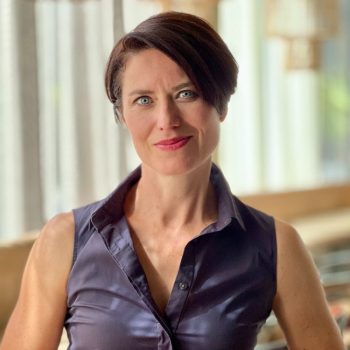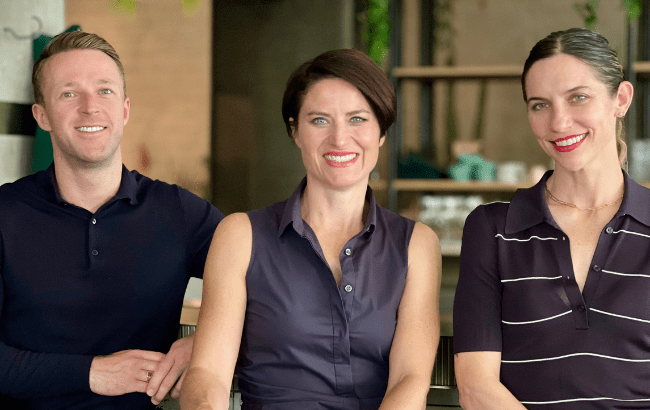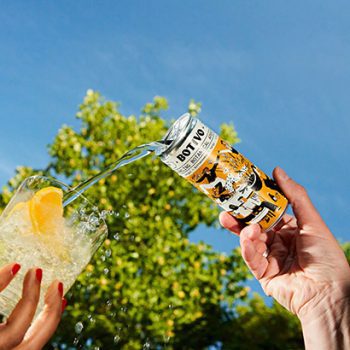How to build effective brand and commercial strategies
By Melita KielyThe founder of drinks consultancy Fox in the Well, Carly Foxwell, is helping brands realise the importance of consumer-first thinking and correctly pricing their products, as well as how to truly create a point of differentiation in a crowded market. She talks to SB about the company’s recent expansion, how to achieve meaningful growth, and why she’s a strong advocate for more women in commercial roles.

“Where we sit with Fox in the Well is between brand teams and commercial teams,” explains Foxwell. “We take great brand strategy and translate that into a really good commercial strategy.”
At the start of July, her drinks consultancy firm, Fox in the Well, announced a rebrand as it welcomed two experienced professionals to the team: Calum McFarlane and Ali Dedianko. In an era where many businesses are scaling back their workforce, Foxwell sees a key opportunity to recruit industry talent that will help her consultancy expand its offerings.
“What’s really neat about the three of us is we’ve got three pillars to our service delivery, the first of those being commercial strategy, which I head up,” Foxwell says. “That’s around really, really strong commercial rigour and commercial foundations, which for almost every client who comes to us, regardless of the stage [of their business], is a challenge.”
Foxwell’s expertise helps brands “know how to put solid commercial foundations on things like pricing, route-to-market models, segmentation – they don’t necessarily know how to do that. So, we support them with laying that down, and then we train them up about how they can deliver it themselves as later-stage brands.”
McFarlane leads the commercial marketing pillar, i.e. preparing to sell products. “How you’re going to win and trade commercial value propositions is a huge part of our work,” Foxwell adds. “This is definitely a pain point for almost every brand that comes to us. You might have an amazing product, liquid, brand and consumer proposition, but it’s how to translate that to something really meaningful to trade and to buyers. We work on selling stories and sales materials, and we offer sales training to help teams.”
It’s far more than just the right product at the right price, though. “We talk about brand value and what it means to buyers, bartenders and trade. We talk about commercial value, obviously, and we talk about product value. Calum leads that,” Foxwell explains.
Advocacy is the third core pillar, which is where Dedianko’s experience really comes into play.
“Ali has got such great experience in liquid credentials, having done liquid development with Belvedere and other brands, and then her expertise is really within that advocacy space,” Foxwell continues. “It’s that winning hearts and minds piece that’s the endpoint. Once you’re in the trade, how do you make sure you’ve got endorsement?”
The trio all share experience with startups and conglomerates alike, including larger firms like Brown-Forman, Red Bull, Edrington, LVMH and Distill Ventures.

Having great liquid is, ultimately, a must for new brand success. But what Foxwell has frequently noticed is that brands are not thinking about the commercial strategy early enough in their development – but they need to.
“Very often, we see the process of what your brand means to consumers, and how that translates to buyers, hasn’t really been thought through. People are missing that step,” she says. “The commercial strategy piece is completely interlinked to the brand and product development. You need to be thinking consumer first. Who’s your end consumer? How does your commercial plan reach them in the right places, at the right pricing, and in the right serves? It’s about making that planning part really holistic, with commercial not being a separate part of the story, but absolutely integrated into it.”
The importance of correct pricing
In the current economic climate, where both businesses and consumers are feeling their wallets squeezed, correct pricing has arguably never been so crucial. Many brands will sell direct to consumers, retailers or venues before partnering with a distributor at a later stage. However, Foxwell has seen brands fall prey to not factoring in those additional distribution costs later down the line when initially pricing their brands. And upping the price later is far from easy.
“We’ve heard a lot about the premiumisation trend that people are drinking less and drinking better,” Foxwell notes. “But we’ve seen evidence that there is a trend of trading down a little bit. Brands need to be very, very confident and clear on the value proposition. You really need to work hard today to make consumers want to pay a premium price. You really need to add value.
“It’s not just product. Consumers are looking for businesses that are purposeful and reflect their values. It’s the whole consideration. We get into quite a lot of those non-money conversations with clients as well. What is the value of your business beyond the cash?”

There is also something to be said for being targeted and specific with your audience. While spirits are, by and large, for all of a legal-drinking age, it is a competitive and saturated space. Much of the industry is currently chasing wealth or younger demographics for their long-term loyalty. But what about demographics often overlooked by marketing campaigns?
“I worked with a brand in Australia, and Calum was also involved in this,” Foxwell recalls. “Their target audience was women in their 50s. Underrepresented consumer groups are a huge opportunity. There can be a rush to create brands for under-35s who live in London. But some of the most exciting brands you’re seeing come to market now are talking to different consumer groups, who have spending power as well.
“A great example is Botivo, one of our long-term clients,” Foxwell continues. “I’ve been working with Imme [Ermgassen] and Sam [Paget Steavenson, the co-founders of Botivo] for two and a half years. It’s a best-practice example of building an opportunity space and capacity creation, and a good example that really strong brand proposition translates to good commercial results because there’s demand. It’s a great example of a brand that’s differentiated.”
Keep reading for further insights into building a strong brand and commercial strategy from Carly Foxwell.
How can, and why should, brands understand their target consumer in the early days of development?
Those seed stage and test-and-learn stages for brands are really important. They let you go really deep on a particular consumer group or cultural space. You can look at the lifestyles of your consumer demographic, where they are socialising – maybe it’s not necessarily the top 50 bars, or the classic outlets we think about in the on-trade. It’s about thinking omnichannel. It really starts with understanding consumer lifestyles, looking at insights from the market, from the category and trade insights.
[At Fox in the Well], we’ll then go out and speak to trade decision makers and niche sub-segments of the on- and off-trade to really get into the skin of what they want out of the proposition. We found that’s a really effective way – particularly for our early-stage businesses or for new product development within later-stage businesses – to be specific about product development, brand messaging, practical sales planning and sales-team hiring.
What is your strategy for the next 12 months as Fox in the Well continues to grow?
At the moment, we want to grow the business meaningfully. In addition to Calum and Ali, we have other partners we’ve brought on board in an ‘ad-hoc’ way. We did that to make sure the services we offer are tailored specifically to the brands and partners we work with. As and when we need their particular set of expertise, we can tap into those extra resources to deliver the best service possible.
The other thing that is really important is female leadership. I am really keen to make sure that I’m being an example to younger women coming into the industry who might not necessarily think commercial jobs are for them, because there are still hardly any women in commercial leadership positions. For me personally, making sure that as we grow the business, we grow with purpose is really important. Supporting women coming into the commercial space is a really, really big thing for me.
How have you seen female representation change during your 20-plus years in the industry?
Not enough. I’ve always been on commercial teams; for me, that’s my heartland. But in 20 years, I’ve had one female boss – and I think that’s really telling. Don’t get me wrong, I’ve had lots of really supportive, really positive male colleagues and bosses. I’ve been very lucky in that respect. But, for some reason, we’re still not seeing many women coming into commercial leadership roles. And, ultimately, if you don’t have enough representation [of women] across your leadership team in all departments, you’re not going to be able to identify these consumer groups that are underserved.
Add to that VC [venture capital] funding being so low for female founders. That’s another really important aspect of that discussion. If we don’t have representation of females in founding brands, then we’re leaving huge opportunities untapped. I read that 15.7% of VC funding globally in food and drink goes to female founders. That’s higher than the less than 2% of VC funding we hear across the board, but it’s still not nearly enough.
What’s your general outlook for the spirits industry in the next 12 months?
I’ve reflected on this a lot, especially given we were working with Distill Ventures for a few years. I think innovation will go back into the hands of smaller startups and independent brands. It’s the lifeblood of spirits. We have to innovate, we have to do new things, we have to evolve to cater for new lifestyle trends, or younger consumers, or those underserved consumers we spoke about before. From a smaller, independent brand point of view, that’s an opportunity that is not going to be dominated so much by the money the big guys have got. That gives those scrappier brands that are really clear in their proposition an opportunity to drive innovation. And, if we draw that line we talked about earlier, between great propositions and commercial results, then that will unlock investment.
Related news
Ex-Glenturret MD launches Baern drinks consultancy
